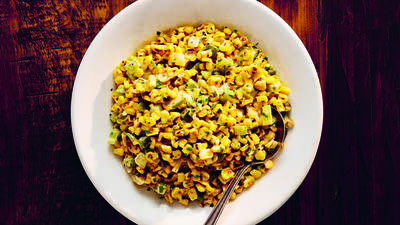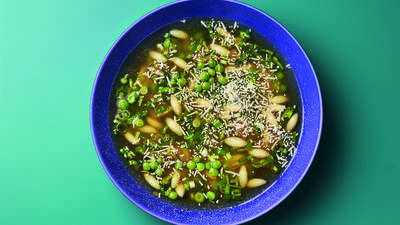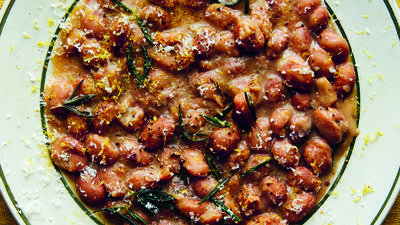
By nurturing a culture of naturally occurring bacteria and yeast, a healthy sourdough starter will leaven bread while also lending it the trademark sour flavor. For a simple, foolproof approach, we began by mixing all-purpose flour with whole-wheat flour, which provided extra nutrition for the developing bacteria and yeasts. We then added enough water to form a wet dough and let it sit at room temperature. After a few days, when it showed signs of life in the form of gas bubbles and a pungent aroma, we began a routine of daily feedings, mixing some of the culture with fresh flour and water to refresh the food supply. After 10 to 14 days, we found that the starter smelled pleasantly yeasty and doubled in volume 8 to 12 hours after the last feeding, a sign that it was ready to use to bake bread. We also came up with an easy way to maintain the starter between uses. We found that we could refresh the food supply just once a week by letting the culture sit for 5 hours at room temperature after feeding it and then moving it to the refrigerator for storage. [Ed. note: Try using your new sourdough starter to make the recipes for Classic Sourdough Bread (Pain au Levain) and Almost No-Knead Sourdough Bread, also provided by America's Test Kitchen.]
Ingredients
4 1/2 cups (24 3/4 ounces) whole-wheat flour
5 cups (25 ounces) all-purpose flour, plus extra for maintaining starter
Water, room temperature
Directions
NOTE: It’s okay to occasionally miss a daily feeding in step 2, but don’t let it go for more than 48 hours. For the best results, weigh your ingredients and use organic flour and bottled or filtered water to create the starter. Once the starter is mature, all-purpose flour should be used to maintain it. Placing the starter in a glass bowl will allow for easier observation of activity beneath the surface. Discarding some starter before each feeding gets rid of waste and keeps the amount of starter manageable.
1. Combine whole-wheat flour and all-purpose flour in large container. Using wooden spoon, mix 1 cup (5 ounces) flour mixture and 2/3 cup (5 1/3 ounces) room-temperature water in glass bowl until no dry flour remains (reserve remaining flour mixture). Cover with plastic wrap and let sit at room temperature until bubbly and fragrant, 48 to 72 hours.
 Sourdough Starter
Photo: Carl Tremblay
Sourdough Starter
Photo: Carl Tremblay
2. FEED STARTER: Measure out 1/4 cup (2 ounces) starter and transfer to clean bowl or jar; discard remaining starter. Stir 1/2 cup (2 1/2 ounces) flour mixture and 1/4 cup (2 ounces) room-temperature water into starter until no dry flour remains. Cover with plastic wrap and let sit at room temperature for 24 hours.
3. Repeat step 2 every 24 hours until starter is pleasantly aromatic and doubles in size 8 to 12 hours after being fed, 10 to 14 days. At this point starter is mature and ready to be baked with, or it can be moved to storage. (If baking, use starter once it has doubled in size during 8-to-12-hour window. Use starter within 1 hour after it starts to deflate once reaching its peak.)
4A. TO STORE AND MAINTAIN MATURE STARTER: Measure out 1/4 cup (2 ounces) starter and transfer to clean bowl; discard remaining starter. Stir 1/2 cup (2 1/2 ounces) all-purpose flour and 1/4 cup (2 ounces) room-temperature water into starter until no dry flour remains. Transfer to clean container that can be loosely covered (plastic container or mason jar with its lid inverted) and let sit at room temperature for 5 hours. Cover and transfer to refrigerator. If not baking regularly, repeat process weekly.
4B. TO PREPARE FOR BAKING: Eighteen to 24 hours before baking, measure out 1/2 cup (4 ounces) starter and transfer to clean bowl; discard remaining starter. Stir 1 cup (5 ounces) all-purpose flour and 1/2 cup (4 ounces) room-temperature water into starter until no dry flour remains. Cover and let sit at room temperature for 5 hours. Measure out amount of starter called for in bread recipe and transfer to second bowl. Cover and refrigerate for at least 12 hours or up to 18 hours. Remaining starter should be refrigerated and maintained as directed.
What Happens When You “Feed” a Starter?
A sourdough starter begins with mixing together just flour and water. As the mixture sits, wild yeast and lactic acid–producing bacteria that are already present in the flour wake up and start to multiply. This is the beginning of your culture of microorganisms that, once healthy and plentiful, will be able to leaven bread and also imbue it with that trademark sour flavor.
So how do you help those microorganisms multiply and grow? By “feeding” the culture daily for a few weeks with fresh flour and water, you provide a new supply of nutrients. (Leaving the culture at room temperature after each feeding is also key—it does best in warmer environments.) At each feeding, you use only a portion of your existing starter and throw away the rest. This encourages faster growth by getting rid of waste the microorganisms have produced. The microorganisms consume the food and multiply and grow until there is no more food left; you then repeat the cycle with another feeding. After a couple of weeks of this, you’ll know the microorganisms are plentiful and healthy because the mixture doubles in size 8 to 12 hours after a feeding—a sign the culture is really active. Your starter is ready for bread baking.
Copyright 2017 America's Test Kitchen. All rights reserved. Used with permission.
Copyright 2017 America's Test Kitchen. All rights reserved. Used with permission.
Before you go...
Each week, The Splendid Table brings you stories that expand your world view, inspire you to try something new, and show how food connects us all. We rely on your generous support. For as little as $5 a month, you can have a lasting impact on The Splendid Table. And, when you donate, you’ll join a community of like-minded individuals who love good food, good conversation, and kitchen companionship. Show your love for The Splendid Table with a gift today.
Thank you for your support.
Donate today for as little as $5.00 a month. Your gift only takes a few minutes and has a lasting impact on The Splendid Table and you'll be welcomed into The Splendid Table Co-op.



